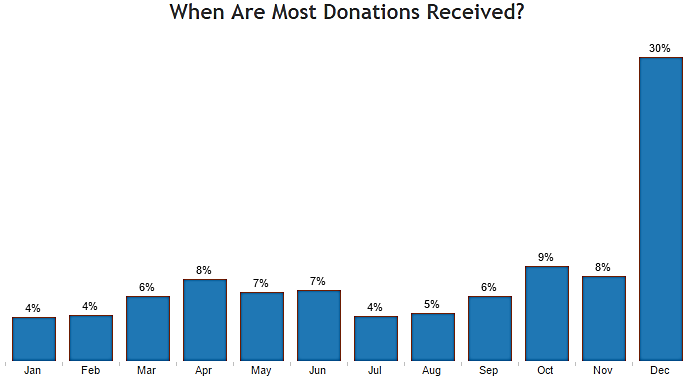Nearly one third (30%) of all annual giving occurs in December. According to Network for Good’s Digital Giving Index, a large portion of those gifts are given in the last three days of the year, just in time for donors to be able to claim those donations in that year’s tax filing.

Needless to say, if that many people donate in late December, you better be sure your donors have a reason and opportunity to direct their donations to your organization! Here are some tips for creating successful year-end appeals that are carefully crafted to reach your specific donors.
Know your donors and categorize them in groups
If a person has already donated to your organization, chances are they are willing to do so again. Put your donors in groups so you can better strategize how to best reach each type of donor you have. Here are some examples:
Members: The membership base of your organization typically consists of people who are already familiar with your organization and believe in what you do. Think of how your members may be motivated to donate as well.
Volunteers: Your volunteers are already donors in a sense. They donate their time. They obviously believe in your organization and its mission. Are there volunteers with your organization that would be interested in making financial donations too?
Patrons: These are the people who participate in what your organization has to offer. They pay for programs, events and other services you might have available and already have an idea of what you do.
Donors: At some point, this group of people felt strongly enough about your mission that they made a financial commitment to you. If that relationship is already cultivated, this group is the most likely to donate more than once and to become regular donors. They are likely already planning to get their donations in by the end of the year and might just need a little reminder.
Create carefully crafted messages
Each group should receive messaging that was created specifically for them. A previous donor should get a different ask than a new member who has never given before. There is one thing that all of your groups have in common and that is an understanding of what your organization does. That means you won’t have to spend too much time introducing your organization and it’s mission the same way you would to new members or potential donors.
Send your year-end appeal in multiple mail-outs
Write a solid appeal to send out this fall. Here is a helpful End-of-Year fundraising appeal checklist to help you get started. Once your content is confirmed, relevant and engaging, try delivering your content in different ways. Instead of sending the entire appeal out all at once, consider staggering it in a set of messages, all pushing the urgency to give before 2017. Here is a timeline and some ideas to take you through the next few months:
October – Send out the initial mass mail-out with your main ask. This could be via email or mail.
November – Create a list of your contacts who didn’t respond to your October mail-out. Send them a second message if that have not donated yet. If you send them mail via post the first time, consider using email for this follow up message.
First week in December – Have your board of directors personally make follow-up phone calls to non-responders thanking them for their involvement with your organization.
December 30th & 31st – Send a short reminder email to those who still haven’t responded. Remind them of the importance of getting those donations in by December 31st so they can still claim them on their 2016 income tax return.
This method might seem a little aggressive, but consider how many emails you get in a given day. Sending one a month, with a few more reminders in December, is considered light communication by most. Plus, the more connections you can make with donors or potential donors, the more they’ll think about you when it comes to give.
Make it easy for them to give
Just because you may have enticed someone to give, doesn’t mean you have secured a donation. If the way you receive and process donations is difficult or time consuming you might lose those donors when they try to follow through. You want to make the actual giving process as easy as possible. Here are some things you should check for:
- Your online donation page has a simple and easy-to-remember web address.
- The “Click here to donate” link is clear and easy to find on any email messages- coloured and on every page of your website.
- The donation page’s web address is clear and easy to find on any print content.
- It is simple for the donor to navigate the donation webpage so they can easily complete the transaction in 60 seconds or less. Be sure it is also mobile friendly!
- You have a confirmation message that acknowledges their donation.
- A thank you letter or email is sent promptly along with a tax receipt.
Thanking your donors will increase donor loyalty, strengthen relationships and will increase the chances of receiving more gifts from that donor in the future. Here are some great tips and a sample thank-you letter to help you get started on creating donor-centred thank-you letters.
If you have any questions about your year-end fundraising or writing an appeal, please feel free to Contact us!
